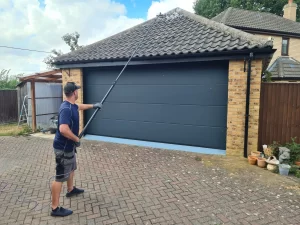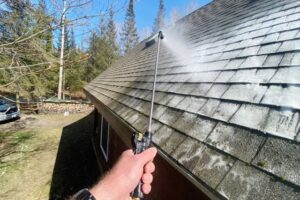Moss growth on roofs is a common problem that homeowners face, particularly in damp and shaded environments. While moss may seem harmless, it can cause significant damage over time, leading to structural issues, leaks, and a shortened lifespan for roofing materials. As a result, the need for effective moss removal solutions has driven advancements in technology, allowing for more efficient, eco-friendly, and long-lasting treatments.
Understanding the Impact of Moss on Roofs
 Moss thrives in moist conditions and spreads rapidly across roofing surfaces, especially those made of shingles, tiles, or wood. Unlike algae or mildew, which often remain as surface-level stains, moss can penetrate the gaps between shingles, lifting them and making the roof more vulnerable to water damage. This growth can lead to rot, mold development, and increased maintenance costs.
Moss thrives in moist conditions and spreads rapidly across roofing surfaces, especially those made of shingles, tiles, or wood. Unlike algae or mildew, which often remain as surface-level stains, moss can penetrate the gaps between shingles, lifting them and making the roof more vulnerable to water damage. This growth can lead to rot, mold development, and increased maintenance costs.
Traditional methods of moss removal included manual scrubbing, pressure washing, or chemical treatments, but each of these approaches has limitations. Manual scrubbing can be labor-intensive and may damage the roof, while pressure washing can strip away protective granules from shingles. Chemical treatments, though effective, can sometimes pose environmental risks. This has led to the development of more advanced roof moss removal technologies.
Advancements in Roof Moss Removal Technologies
With growing awareness of sustainability and efficiency, the roofing industry has embraced new technologies to combat moss growth without causing damage to the environment or the roof itself. These advancements range from innovative cleaning solutions to preventive treatments that inhibit future moss growth.
Biodegradable and Eco-Friendly Cleaning Agents
One of the most significant improvements in roof moss removal is the development of biodegradable and eco-friendly cleaning agents. Unlike traditional bleach-based solutions that can harm plants and wildlife, these newer formulations rely on natural enzymes or organic compounds to break down moss growth.
These solutions work by targeting the moss at a cellular level, effectively weakening its structure and preventing regrowth. Some products include time-release formulas, allowing for a gradual breakdown of moss over several weeks without the need for immediate rinsing. This eliminates runoff concerns and reduces the impact on the surrounding environment.
Soft Washing Techniques for Gentle Cleaning
Soft washing has emerged as an effective alternative to pressure washing, utilizing low-pressure water combined with specialized cleaning solutions to remove moss without damaging roofing materials. This technique ensures that shingles remain intact while the moss is safely removed.
Soft washing technology often incorporates long-lasting treatments that create a protective barrier against future moss growth. Unlike traditional power washing, which can dislodge roofing granules and accelerate wear, soft washing preserves the integrity of the roof while maintaining its aesthetic appeal.
Copper and Zinc-Based Prevention Systems
 Preventing moss from returning is just as important as removing it, and metal-based solutions such as copper and zinc strips have gained popularity as long-term prevention methods. These strips are installed along the ridgeline of the roof, and when rainwater runs over them, trace amounts of metal ions are released, creating an inhospitable environment for moss growth.
Preventing moss from returning is just as important as removing it, and metal-based solutions such as copper and zinc strips have gained popularity as long-term prevention methods. These strips are installed along the ridgeline of the roof, and when rainwater runs over them, trace amounts of metal ions are released, creating an inhospitable environment for moss growth.
Copper and zinc have natural antimicrobial properties that inhibit the development of moss, algae, and lichen. This technology has been widely adopted in roofing designs as a passive and low-maintenance way to keep roofs clear of unwanted growth for years.
Nanotechnology and Surface Coatings
Recent advancements in nanotechnology have introduced protective coatings designed to repel moss and other organic growth. These coatings create a hydrophobic surface that prevents moisture retention, making it difficult for moss to take root.
Unlike traditional sealants, nanotechnology-based coatings are engineered at the microscopic level to bond with roofing materials without altering their appearance. Some coatings also include UV-resistant properties, further enhancing the longevity of the roof while reducing maintenance needs.
Robotic and Automated Cleaning Systems
Automation has made its way into the field of roof maintenance, with robotic cleaning systems now available to remove moss efficiently. These systems are designed to navigate roof surfaces using gentle cleaning mechanisms that eliminate moss without human intervention.
Robotic cleaners can be equipped with soft-bristled brushes, biodegradable cleaning solutions, or low-pressure water systems to provide thorough moss removal. Some models are even programmed with AI-powered navigation, ensuring they cover the entire roof area without missing spots.
This technology is particularly useful for homeowners with large or steeply sloped roofs where manual cleaning would be hazardous. Additionally, automated systems minimize labor costs and reduce the need for frequent maintenance.
Choosing the Right Moss Removal Solution
Selecting the most appropriate moss removal solution depends on various factors, including roof type, climate, budget, and long-term maintenance goals. Homeowners should consider whether they need a one-time cleaning solution or a preventative approach to avoid future moss growth.
For environmentally conscious homeowners, biodegradable and enzyme-based cleaners offer a safe and effective method. Those looking for long-term prevention may opt for copper or zinc strips, while those interested in cutting-edge technology might explore nanotechnology coatings or robotic cleaning options.
Consulting with a professional roofing specialist can help determine the best solution based on the specific needs of the roof. Some solutions may also be combined for a comprehensive approach, such as using a soft wash cleaning method followed by the installation of preventative strips or coatings.